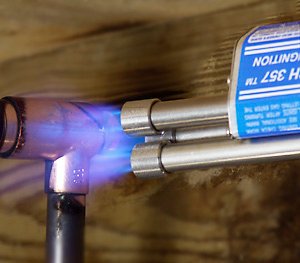|
|
Advantages of
Torch Brazing

Although there is a popular belief that brazing is an inferior
substitute for welding, it has advantages over welding in many
situations. For example, brazing brass has a strength and hardness
near that of mild steel and is much more corrosion-resistant. In
some applications, brazing is highly preferred. For example, silver
brazing is the customary method of joining high-reliability,
controlled-strength corrosion-resistant piping such as a nuclear
submarine's seawater coolant pipes. Silver brazed parts can also be
precisely machined after joining, to hide the presence of the joint
to all but the most discerning observers, whereas it is nearly
impossible to machine welds having any residual slag present and
still hide joints.
- The lower temperature of brazing and brass-welding is less
likely to distort the work piece, significantly change the
crystalline structure (create a heat affected zone) or induce
thermal stresses. For example, when large iron castings crack,
it is almost always impractical to repair them with welding. In
order to weld cast-iron without recracking it from thermal
stress, the work piece must be hot-soaked to 1600 °F. When a
large (more than fifty kilograms (100 lb)) casting cracks in an
industrial setting, heat-soaking it for welding is almost always
impractical. Often the casting only needs to be watertight, or
take mild mechanical stress. Brazing is the preferred repair
method in these cases.
- The lower temperature associated with brazing vs. welding
can increase joining speed and reduce fuel gas consumption.
- Brazing can be easier for beginners to learn than welding.
- For thin workpieces (e.g., sheet metal or thin-walled pipe)
brazing is less likely to result in burn-through.
- Brazing can also be a cheap and effective technique for mass
production. Components can be assembled with preformed plugs of
filler material positioned at joints and then heated in a
furnace or passed through heating stations on an assembly line.
The heated filler then flows into the joints by capillary
action.
- Braze-welded joints generally have smooth attractive beads
that do not require additional grinding or finishing. The most
common filler materials are gold in colour, but fillers that
more closely match the color of the base materials can be used
if appearance is important.
SOURCE |
What is Torch Brazing ?
Brazing vs Welding
Buy a Brazing Torch/ Reviews
Advantages of Torch Brazing
Limitations of Torch Brazing
Torch Brazing company
Brazing Tips
Heat Sources of Brazing
Cleaning the Braze joint
Particle Size chart
Brazing Paste
Eye Protection for Brazing
All Torch Brazing Links |
